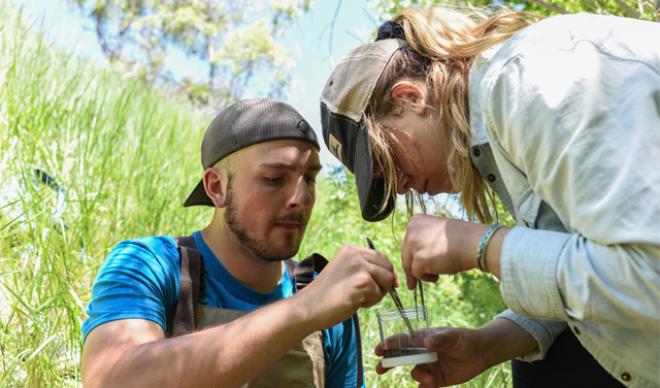
A video version of the story can be found here.
Nestled between the ridges of the Boise foothills of Southwest Idaho lies Dry Creek. During the summer, the water flow dries up. But a genetically pure population of redband trout still survive in these stressful environments — seeking refuge in remnant pools and living in rising temperatures thought to be uninhabitable for trout. Two College of Idaho juniors-to be and a recent graduate are researching what conditions determine the fate of the fish.
The student research team, led by College of Idaho professor of biology Dr. Chris Walser, is spending the summer collecting data from Dry Creek. The students are studying the effects of reduced creek flow on redband trout survival. They are measuring Dry Creek’s width, depth, temperature, water quality and the food resources the fish depend on like aquatic insects.
This research is funded by the Murdock Charitable Trust through a two-year grant. In the first year, the trust grants the College roughly $100,000 to support multiple teams of student and faculty researchers and the equipment used. Walser has been working with students in the Dry Creek area for eight years to study the redband trout habitat.
“Every year we add another dimension to our study,” said Walser. “We really mentor our students well and we provide opportunities like this that for most students, they’re not going to be able to work this closely with a research professor until they’re in graduate school.”
The students agreed this was an opportunity they didn’t want to pass up. Biology majors Andrew Wymore, Lydia Brown and 2019 biology graduate Travis Landon have been enjoying this experience. “We have a great team here,” said Wymore. “I love working with these guys.” The goal for Wymore is to contribute to the base of knowledge about the redband trout in Dry Creek.
Their research is showing that stream ecology is changing. “I feel really passionate about this,” said Brown. “I’m able to work toward the greater project of reacting to climate change and being able to have the power to preserve populations at really high risk.”
Trout typically fare better in colder temperatures and deeper water. Which makes this genetically pure population in the Boise foothills so unique. “It’s kind of amazing that they can survive up here when all other fish would have died at this point,” said Landon. “But if it takes too long for these flows to start again, they might not make it, which will lead to a drop off in the entire population.”
Their research will continue through August and once the work is done, the students will present their findings at a professional conference. This experience gives students a higher likelihood of being accepted into graduate school and working in the field of fisheries and stream ecology. “As a professor, it makes you feel like your time is well-spent and that you are able to shape the future,” said Walser.
The College of Idaho has a 128-year-old legacy of excellence. The C of I is known for its outstanding academic programs, winning athletics tradition and history of producing successful graduates, including seven Rhodes Scholars, three governors, and countless business leaders and innovators. Its distinctive PEAK Curriculum challenges students to attain competency in the four knowledge peaks of humanities, natural sciences, social sciences and a professional field—empowering them to earn a major and three minors in four years. The College’s close-knit, residential campus is located in Caldwell, where its proximity both to Boise and to the world-class outdoor activities of southwest Idaho’s mountains and rivers offers unique opportunities for learning beyond the classroom. For more information, visit www.collegeofidaho.edu.